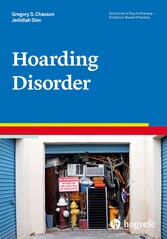Suchen und Finden
Service
Hoarding Disorder
Gregory S. Chasson, Jedidiah Siev
Verlag Hogrefe Publishing, 2018
ISBN 9781616764074 , 76 Seiten
Format PDF, OL
Kopierschutz Wasserzeichen
|1|1
Description
1.1 Terminology
Hoarding disorder is a new disorder in the Diagnostic and Statistical Manual of Mental Disorders, 5th edition (DSM-5; American Psychiatric Association, 2013, Sect. 300.3), as well as in the International Classification of Diseases, 11th edition (ICD-11; World Health Organization, 2018, Sect. F42, subsection 6B24), where it is included in the respective “Obsessive-Compulsive and Related Disorders” chapter. However, hoarding behavior is not a new or newly discovered phenomenon. The roots of the term hoarding and the presence of hoarding behavior throughout human history are outlined extensively elsewhere (Penzel, 2014). The word hoarding comes from the word hord in Old English, meaning “treasure, valuable stone or store” (Penzel, 2014). According to Penzel, there is evidence of hoarding behavior as early as the very beginning of humankind, and classical literature is peppered with references to hoarding, such as in Dante Alighieri’s well-known poem “Inferno”; Gogol’s main character in Dead Souls from 1842; and Krook, a character in Dickens’ Bleak House from 1862. There are even possible allusions to hoarding in both the Old and New Testaments of the Bible. Specific individuals in history have also been associated with hoarding – for example, the Collyer brothers, Howard Hughes, and the Bouvier Beale mother-and-daughter pair.
Recently, hoarding behavior has received considerable media exposure. Reality television shows such as Hoarders and Buried Alive garner sizable and profitable viewerships. Popular films, like the 2004 Howard Hughes biographical drama The Aviator, have increased the spotlight on hoarding for the public. On the museum circuit, the clutter of Zhao Xiangyuan, the late Chinese citizen from Beijing with hoarding difficulties, has been displayed as an exhibit by her artist son, Song Dong.
The visibility of hoarding behavior throughout history is not reflected in its relative lack of attention in the community of medical and social scientists and theoreticians. Exceptions include early discussions of hoarding by William James (1890), who wrote of instinct and the importance of acquisition behavior in the formation of personal identity; and by Erich Fromm (1947), who introduced the hoarding orientation as one of several personality types, characterizing it as a tendency to view the world as composed of possessions to keep and value.
Hoarding behavior was included in previous versions of the DSM, but only as a single criterion for obsessive-compulsive personality disorder (OCPD), starting in 1980. However, in the early 1990s, Frost and colleagues set the stage for modern theory and research on hoarding behavior when they |2|published seminal research (Frost & Gross, 1993) and articulated a cognitive behavioral model of hoarding (Frost & Hartl, 1996). Since Frost and Gross (1993), the number of research articles in PsycINFO with a keyword hoarding (with human participants set as a parameter of the search) has increased nearly 19-fold, highlighting the increase in scientific attention and growing evidence base.
1.2 Definition
Hoarding disorder is characterized by difficulty parting with items because of the need to save them and distress from discarding them, regardless of their value. Hoarding behavior results in clutter that interferes with the ability to use living spaces as intended, unless someone else intervenes to limit the clutter. The majority (60–90%) of individuals with hoarding disorder engage in excessive acquisition of new objects as well, and the clinician can code this (e.g., for billing or research purposes) by specifying “with excessive acquisition” (Frost, Rosenfield, Steketee, & Tolin, 2013; Frost, Tolin, Steketee, Fitch, & Selbo-Bruns, 2009; Mataix-Cols, Billotti, Fernández de la Cruz, & Nordsletten, 2013; Timpano et al., 2011).
Hoarding disorder is a new diagnosis in DSM-5 and ICD-11; previously, individuals with hoarding would have been diagnosed with obsessive-compulsive disorder (OCD) or OCPD. In fact, before DSM-5, diagnostic criteria pertaining to hoarding behavior were mentioned in only one section of the DSM: the fifth criterion of OCPD, where “[he or she] is unable to discard worn-out or worthless objects even when they have no sentimental value” (American Psychiatric Association, 2000, p. 729). Notably, apparent hoarding behavior (e.g., unwillingness to discard, excessive acquisition) can indicate numerous diagnoses, and hoarding disorder is not diagnosed when the symptoms are better accounted for by another condition, including OCD. For example, an individual with excessive clutter because of obsessions related to contamination or because of the need to complete elaborate compulsions before discarding would be diagnosed with OCD, not hoarding disorder.
Poor insight is common among individuals who hoard, and when coding the diagnosis, the clinician should specify degree of insight. In fact, more than half of individuals with hoarding have poor or delusional levels of insight (Tolin, Frost, & Steketee, 2010). Poor insight can manifest in several ways, including lack of appreciation of the severity of the problem or its impact on related consequences; rigid, fixed, and unreasonable beliefs about possessions; and defensiveness (Frost, Tolin, & Maltby, 2010). Degree of insight is a particular concern with this population because low insight has been associated with lack of motivation, treatment dropout, therapy-interfering behaviors, and poor treatment outcome (Frost et al., 2010).
The DSM-5 criteria for hoarding disorder are provided in Table 1. The ICD-11 criteria for the disorder are similar to those found in DSM-5 and emphasize the accumulation of possessions as a result of difficulty discarding or excessive acquisition, accumulation of belongings that results in the inability to use or remain safe in living spaces, and associated functional impairment
|3|Table 1 DSM-5 Diagnostic Criteria for Hoarding Disorder
Specify if:
|



